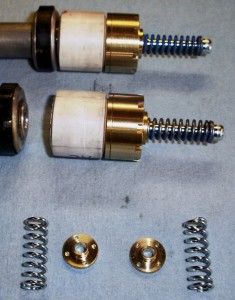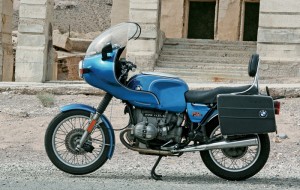A vintage bike is a two-edged sword. On the one hand is the joy of having other riders come over and say, “Nice bike! What year is it?” On the other are the problems associated with vintage electrics, vintage reliability, vintage suspension and anti-stop brakes.
My old bike of choice is a 1976 BMW R75/6, which I bought used in 1985 and that now has traveled more than 105,000 miles. I added a period sport-touring fairing and eight-gallon Heinrich tank, and overall the bike has been very reliable. In recent years, however, its fork sliders have been leaking, and that oil blows onto the brake caliper and rotor creating a dangerous situation. Also, the stock front suspension on these bikes was so softly sprung that back in the ’70s Cycle magazine’s Editor Cook Neilson once likened its action under heavy braking to that of an elephant kneeling for its mahout. Despite my adding progressively wound aftermarket fork springs, anti-dive springs and heavier fork oil when I first bought the bike, its front suspension wore out long ago, leading to sloppy handling, uncertain damping and a choppy ride.

Race Tech in Corona, California, is known for its Gold Valve Cartridge Emulators that, in concert with proper fork springs and fork oil, are inserted in a motorcycle fork to restore its ride and handling characteristics. When I learned that this product was also available for vintage machines, including a complete fork rebuild service, I talked with Matt Wiley, Race Tech’s Vintage R&D Technician. Because of the persistent leak, age and miles on my bike, Wiley recommended a complete fork rebuild. He asked for my weight, would I carry a passenger (no), did I carry luggage (yes, often full camping gear), how did I ride (aggressively), and how did I want it to ride (toward the taut, well-controlled side).
I sent the fork tubes and sliders to Wiley and about two weeks later my fork was returned, cleaned up, rebuilt and fully assembled including oil, fork springs and the emulators. The emulator is a device that installs within each fork tube and sits below the fork spring. It has a through-bolt surrounded by a spring at the top. Its thick base is the same diameter as the inside of the fork tube and contains a rebound damping port, blow-off valve, compression check valve with damping orifice, and adjuster nut. Along with it came a very detailed guide to tuning should I wish to change the setup. In general, it’s important to understand that there is no right or wrong setting, only what feels right to the rider. Secondly, note that the emulators control compression damping while fork oil viscosity controls rebound damping.

With the fork reinstalled, there was a lack of oil drips below the sliders—the leak was gone! On my first ride, I noted that the handlebar, which previously had kicked back, puttered and been active in my hands over bumps was now quiet as the fork was absorbing bumps that previously had been passed along. The fork springs dialed in to my weight and preferences provided a taut ride that was much like that of a modern bike, and unwanted fork dive was gone. Had I left my original fork stock with its softness and excessive diving, the difference would have been even more dramatic. Note that emulators vary only in physical size in order to be compatible with various fork applications, but the setup adjustments are similar. In other words, everything stated here carries over to a modern bike, too. Emulators do require the use of Race Tech fork springs in all vintage applications, and they are strongly recommended on modern bike applications, as well.

For me to further adjust the emulators would involve placing the bike on a stand, removing the fork caps, fishing the devices out and, depending upon intent, resetting pop-off springs and/or fork spring preload, changing to a different rate spring or bleeding the emulator valve and changing oil viscosity or level. Each move would affect ride or handling. At present, however, I am so enjoying the new tautness and control that I have no immediate plans to make any changes.
The Gold Valve Cartridge Emulator kits retail for $169-$200 depending upon application; fork springs are $114-$140; and wear/tear parts $25-$125. Labor is $125-$150 if the fork is sent to Race Tech for a rebuild.
For more information, call (951) 279-6655 or visit racetech.com
(This Gear Lab review was published in the June 2013 issue of Rider magazine.)








Are this emulators suitable for 2008 BMW F8OOS ? As the front fork stock are soft and causing fear when sudden brake / corners.
Kindly advice us. Thanking you all in advance.
Moha.
Are this emulators suitable for 2008 BMW F8OOS ? As the front fork stock are soft and causing fear when sudden brake / corners.
Kindly advice us. Thanking you all in advance.
Moha.